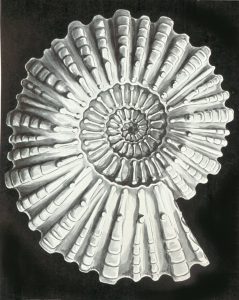Poetry Forms: Fibonacci

Ernest Haeckel, Public domain (https://en.wikipedia.org/wiki/File:Haeckel_Douvilleiceras_mammillatum.jpg)
If you’re looking for a really interesting poetry form to try out, check out the Fibonacci. This form uses the numerical pattern of the Fibonacci sequence as the syllable count for each line (ooh boy, MATH!). So your first and second lines both have one syllable, and your third line is the sum of those two lines, so three syllables. Then each subsequent line has a number of syllables equal to the sum of the two lines before it: five, eight, thirteen. You could stop there, or you could keep going. If you keep going, your lines will wind up quite long very quickly, though!
You could also use the numerical pattern to set up a stanza, and then have the next stanza either match or mirror (starting with the syllable count of the last line of the first stanza, and then counting down until the last two lines are one syllable each) the pattern. Some people use Fibonacci poetry to make a visually stunning piece by centering each line and using the ascending and descending syllable count to create something that looks like a top with a narrow horizontal plane (like the one pictured here). It would probably be trickier to mimic the spiral pattern of this shell, but I think it could be done by a skilled artist!

Comments